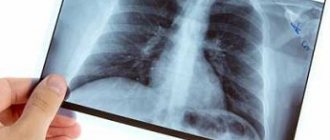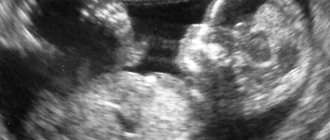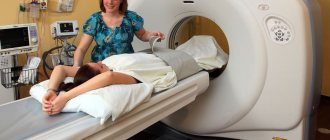Hello, dear readers! Pregnancy is not a disease, but just a temporary and rosy state. Nevertheless, the health and life of the unborn baby often depends on its course. And even if they are entirely in the hands of nature, at a critical moment doctors will still be able to do something.
True, provided that the danger is identified in a timely manner. This can be done today in several ways, including absolutely safe ones. One of them is fetal CTG. What is it, when, why and why is it prescribed? This is what we will talk about. And at the same time we’ll find out whether we should be afraid of him.
Why is it prescribed?
CTG monitors the rhythm of the fetal heart, the frequency and strength of uterine contractions in a woman.
The listed indicators depend on the presence of pathological processes and external factors, so on their basis they make a conclusion about the child’s health. The following factors or symptoms are indications for CTG:
- pathological diagnoses after earlier studies;
- infectious diseases of pregnant women;
- difficulties in bearing first children;
- gene or chromosomal mutations in the parents' families;
- suspicious mobility or passivity of the fetus;
- high or low water levels;
- premature maturation of the placenta;
- threat of early birth during any period of pregnancy;
- conception outside the country, especially in tropical countries;
- vaccination with a drug that disrupts fetal formation;
- symptoms of gestosis;
- drug therapy during pregnancy;
- chronic and autoimmune diseases in pregnant women;
- smoking, drinking and drug addicted mothers.
The presence of these factors increases the risk of developing pathologies; such women should take a particularly responsible approach to the diagnosis of pathologies and undergo a high-precision examination using CTG.
The effect of the procedure on the fetus
Is it harmful to do CTG during pregnancy? Experts say that the manipulation is completely safe for mother and child. To date, there are no documented episodes of deterioration of health, complications, miscarriages or illnesses after the examination.
However, many women have encountered the feeling that the child does not like the manipulation - when electrodes are applied, the baby becomes quiet and hides or begins to behave too violently. Both of these worsen diagnostic results.
In addition, it is known that the baby hears a rather strong sound during CTG. For some mothers, this becomes a direct contraindication to the procedure. It has been established that approximately 20% of children experience such discomfort during manipulation.
You should not take CTG too seriously during pregnancy. Diagnostics give only an approximate idea of the baby’s condition during the day. The next day everything can change and the result will be better. In addition, the conclusion made by the doctor does not always correspond to the actual severity of the condition. After all, people tend to make mistakes. Therefore, the results of fetal CTG should be considered only in conjunction with ultrasound examination and Doppler.
List of sources:
- Obstetrics: Textbook for honey. universities – 2nd ed. / Ailamazyan E. K. // St. Petersburg: SpetsLit, 2000.
- Obstetrics / Bodyazhina V.I., Zhmakin K.N., Kiryushchenkov A.P. // Kursk: GUIPP “Kursk”, 1998.
- Obstetrics: Textbook. / Savelyeva G. M. et al. // M.: Medicine, 2000.
- Assessment of fetal condition. Cardiotocography. Doppler. Biophysical profile; Textbook allowance. / Voskresensky S. L. // Minsk: Book House, 2004.
- Order of the Ministry of Health of the Russian Federation dated November 1, 2012 N 572n “On approval of the procedure for providing medical care in the field of obstetrics and gynecology (except for the use of assisted reproductive technologies)” (with amendments and additions).
Author
Elena Medvedeva
Specialist
Graduated from the Ural State Medical Academy of Yekaterinburg with a degree in General Medicine. Work experience: intensive care team, physician at an enterprise. All articles by the author
I like!
Diagnostic plan
The CTG schedule depends on the detected pathologies:
- increased duration of pregnancy (more than 42 weeks) – once every 4-5 days;
- negative Rh factor in the mother - 2 times a month;
- high or low water, heart disease, excess thyroid hormones (hyperthyroidism of any severity) - once every 7 days;
- large child, multiple pregnancy, clinically narrow pelvis - once every ten days;
- rubella suffered during pregnancy, high blood pressure, genitourinary infections, placenta previa in the absence of bleeding, woman age over 35 years - once every ten days.
The Ministry of Health of the Russian Federation has determined that CTG should be performed from the 28th week, once every 10 days.
Practicing doctors, if the pregnancy is proceeding normally, prescribe it from the 32nd week at intervals of 2 times a month. In case of complications, CTG is done from the 28th week with an interval of 5-7 days. In particularly difficult cases, it is carried out daily.
Who conducts
A referral sheet for CTG is issued by the doctor observing the pregnancy. The procedure is performed by a specially trained midwife or obstetrician-gynecologist. Only an obstetrician-gynecologist can analyze the data obtained correctly and determine the presence of pregnancy pathologies.
Preparation for the procedure
CTG results do not depend on food intake. For the woman’s comfort, it is better to come 2-3 hours after eating. 2 days before CHT it is forbidden to consume:
- drinks containing caffeine, cocoa (tea, coffee);
- limit dark chocolate (no more than one bar);
- alcohol, energy drinks.
- a large amount of protein foods.
The main condition is that the woman should not be nervous. You should not take sedatives or painkillers before the study. Before starting, be sure to visit the toilet.
About coffee and mobile phone
Coffee does not have the best effect on the body of a woman and the fetus. After it, the mother’s pulse and blood pressure increase, and oxygen delivery to the fetus decreases, which negatively affects CTG. Some of the caffeine necessarily passes through the placenta to the fetus, as a result the tocogram will give incorrect data.
Ultrasonic waves, the reflective features of which are used in the technique, do not react in any way to cellular communications. You can take your mobile phone with you to the procedure.
What to carry
The process is accompanied by the use of a special gel.
After the examination, the gel will need to be removed, for which you need to have a small towel or several paper napkins with you. Have a couple of candies, cookies (something sweet) with you. The intake of sugar stimulates the mobility of the fetus, which increases its heartbeat.
Some clinics recommend having a small pillow or blanket; these items will help you find a comfortable position that will need to be maintained for a certain time.
Correct position during the procedure
During the examination, the woman sits on a special couch; it is correct to raise her head slightly. You should take a “half-sitting” or “half-lying” position on your left side.
Pregnant women should not lie on the right side of the body for a long time; in this position, the inferior vena cava is compressed, which can provoke various complications. It is not allowed to be in a horizontal position or lie flat on your back during the procedure.
How to prepare for research
CTG does not require special preparation. However, given the fact that the study lasts 40-60 minutes, you need to tune in to it, take a book or magazine with you (to somehow pass the time). Before the study, you should not overeat or, on the contrary, starve, because this can affect the baby’s behavior. The ideal option is to arrive rested, in a good mood and with a little snack. And of course, before going for a CTG, you must definitely visit the toilet - otherwise the examination time will seem like an eternity.
During this procedure, you need to take a comfortable position: reclining or lying on your side. There is no need to lie on your back - this is both uncomfortable and may affect the results of the study.
Scheme of implementation
CTG is performed using specialized equipment in a certain sequence:
- Immediately before the start of the process, using a stethoscope, the place where the fetal heartbeat can be clearly heard is determined.
- It is at this place that the ultrasonic sensor is fixed with a special belt. In some devices, the sensor is equipped with a Doppler function, which allows you to determine the direction of blood in the child’s vessels.
- A tansometric sensor is placed in the upper abdomen (fundus of the uterus). It allows you to track uterine contractions and fetal movements.
Sometimes a woman, at the moment of fetal movement, should press the button of a special hand-held device. All other elements of the equipment must operate in automatic mode.
Data logging
Information from receiving devices is recorded on paper tape in the form of two curved lines:
- the top line reflects the heart rate (heart rhythm) of the child;
- bottom line – uterine contractions.
It is the resulting curved lines that the doctor examines to determine the child’s condition.
Fetal monitor
Modern CTG machines are equipped with a fetal monitor that transmits cardiography data in real time.
All data can be recorded on paper. Such devices also have several sensors with Doppler function, designed to study multiple pregnancies.
Duration
It is difficult to unequivocally answer the question of how long CHT will last. On average, the research takes 30-40 minutes, sometimes 10-15 minutes is enough, and sometimes a whole hour is not enough.
During CTG, it is necessary to record the fetal heart rate, the dependence of this parameter on uterine contractions and its independent movements. For this, the fetus must be awake and moving, and not sleeping.
Decoding the results
CTG data is analyzed in 2 ways:
- automatic, performed by the device itself, the heart rhythm is analyzed in the calm and active state of the fetus;
- manual, performed by a specialist, requires a certain amount of time.
The condition is determined on a ten-point scale, according to the scheme:
- from 8 to 10 points – an absolutely healthy fetus;
- 5-7 – borderline condition, the development of serious complications is possible with a high degree of probability;
- 3-4 – severe hypoxia with a potential threat of a fatal outcome;
- 3 or less – there is a threat of fetal death, urgent measures are required to maintain its cardiac activity.
Automatic decoding is considered relatively correct; it is not the basis for making a final diagnosis. The data is deciphered by a diagnostician or gynecologist, the result obtained is considered more reliable and correct, and is checked against the automatic version.
Heart rate indicators corresponding to the norm
The basal rhythm (number of beats per minute) of the heart corresponds to normal values depending on the stage of pregnancy:
- at 32 weeks within 120-160 beats per minute;
- 33rd, 34th weeks – no changes;
- 35th week – 119-160 beats/min;
- 36th, 37th weeks – 120-160 beats/min.
The rhythm of heart contractions, along with the duration of pregnancy, is also determined by the mobility of the fetus.
Normal fetal activity
Activity also depends on the duration of pregnancy and the presence of complications: hypoxia, oligohydramnios.
Peak activity occurs at 28-32 obstetric weeks.
In a normal pregnancy, the duration of sleep in the fetus at this stage should not exceed 50 minutes (on average 30-40 minutes).
Therefore, the mother should feel the baby moving after this time interval.
Reasons for concern may include long periods of calm (more than 12 hours) and pronounced lethargy.
What does CTG reveal?
CTG allows timely and correct diagnosis of severe pathological processes:
- A complex of disorders of the placenta (fetoplacental insufficiency). Often leads to fetal death.
- Intrauterine infections. A group of intrauterine diseases of an infectious nature, leading to the development of birth defects, developmental delays, and fetal death.
- The third degree of maturity of the placenta is earlier than the established period.
- Hypoxia is the cause of many diseases that threaten the life of the fetus.
- Diagnosis of diabetes during pregnancy leads to the development of hyperglycemia in the baby (the baby's body is not able to produce insulin on its own).
The expectant mother can refuse CTG (preferably in writing), but experts strongly recommend not to ignore the accurate method of monitoring pregnancy.
How often can cardiotocography be done?
Cardiotocography is a safe examination and does not affect the child’s development. In addition, CTG is completely painless; during it, you do not need to take any medications or do any additional medical procedures (injections, etc.). Therefore, there are no contraindications for performing CTG. This procedure can even be done daily and can be repeated for a long time if necessary.
CTG should be performed while the baby is awake. If he is sleeping during the examination, then you should not specifically wake him up. It’s just that the CTG time will lengthen a little or the study will have to be repeated.
CTG is included in the list of mandatory studies during pregnancy, and it can be done free of charge at any antenatal clinic or in nearby maternity hospitals. And of course, CTG can be done at any paid medical center that has a pregnancy monitoring program.
What to do if the results are questionable or negative
There are cases when CTG gives an ambiguous result, which makes it impossible to establish an accurate diagnosis.
Then the doctor may prescribe a repeat CTG or, to obtain additional information, refer the pregnant woman for laboratory tests or other studies, for example, ultrasound. CTG is a highly informative and reliable method of research, is effective for assessing the cardiac activity of the fetus in the later stages and allows you to identify a number of severe pathologies. Timely identified deviations allow doctors to take the right steps to preserve the health of the mother and child.











